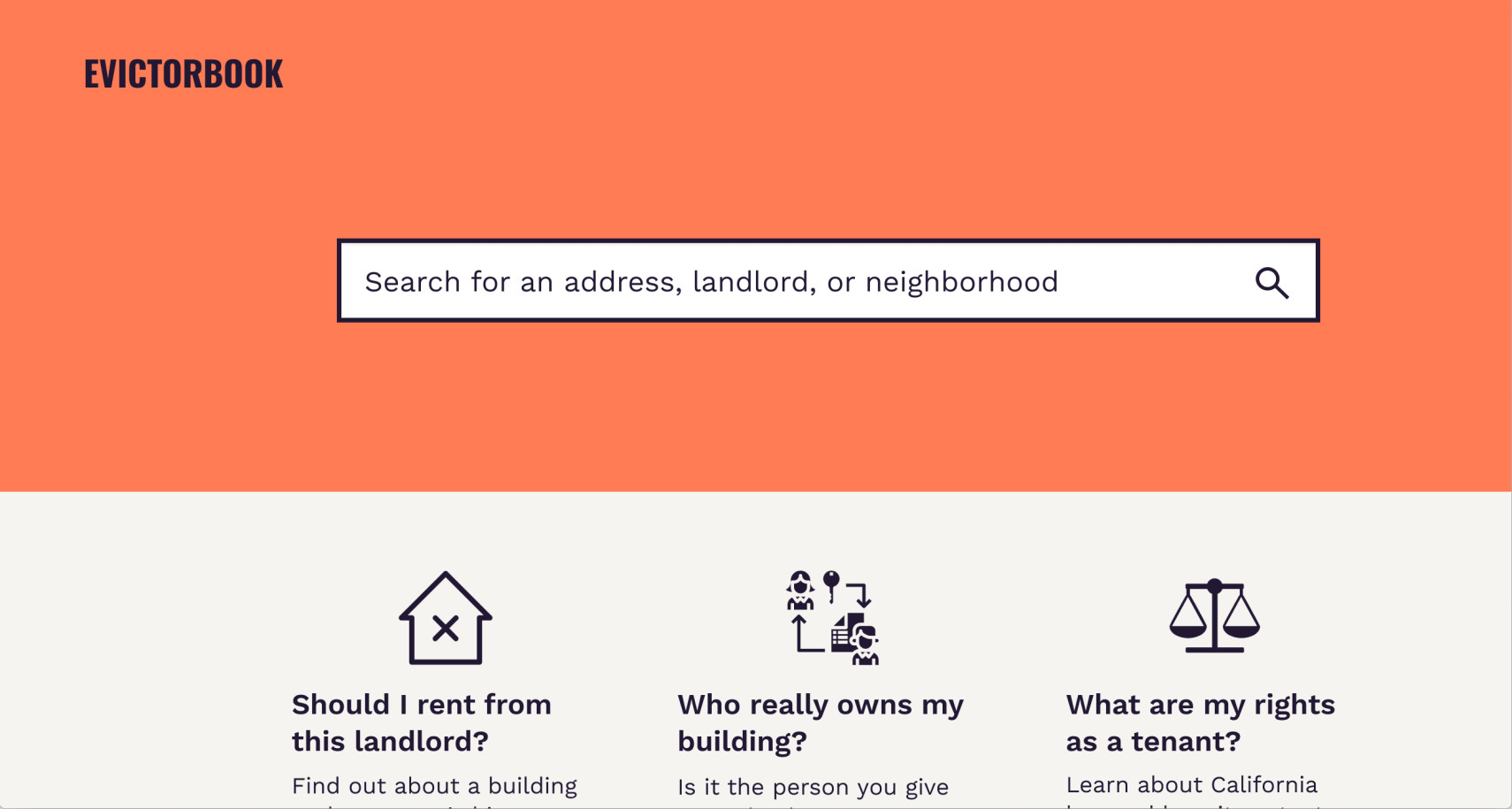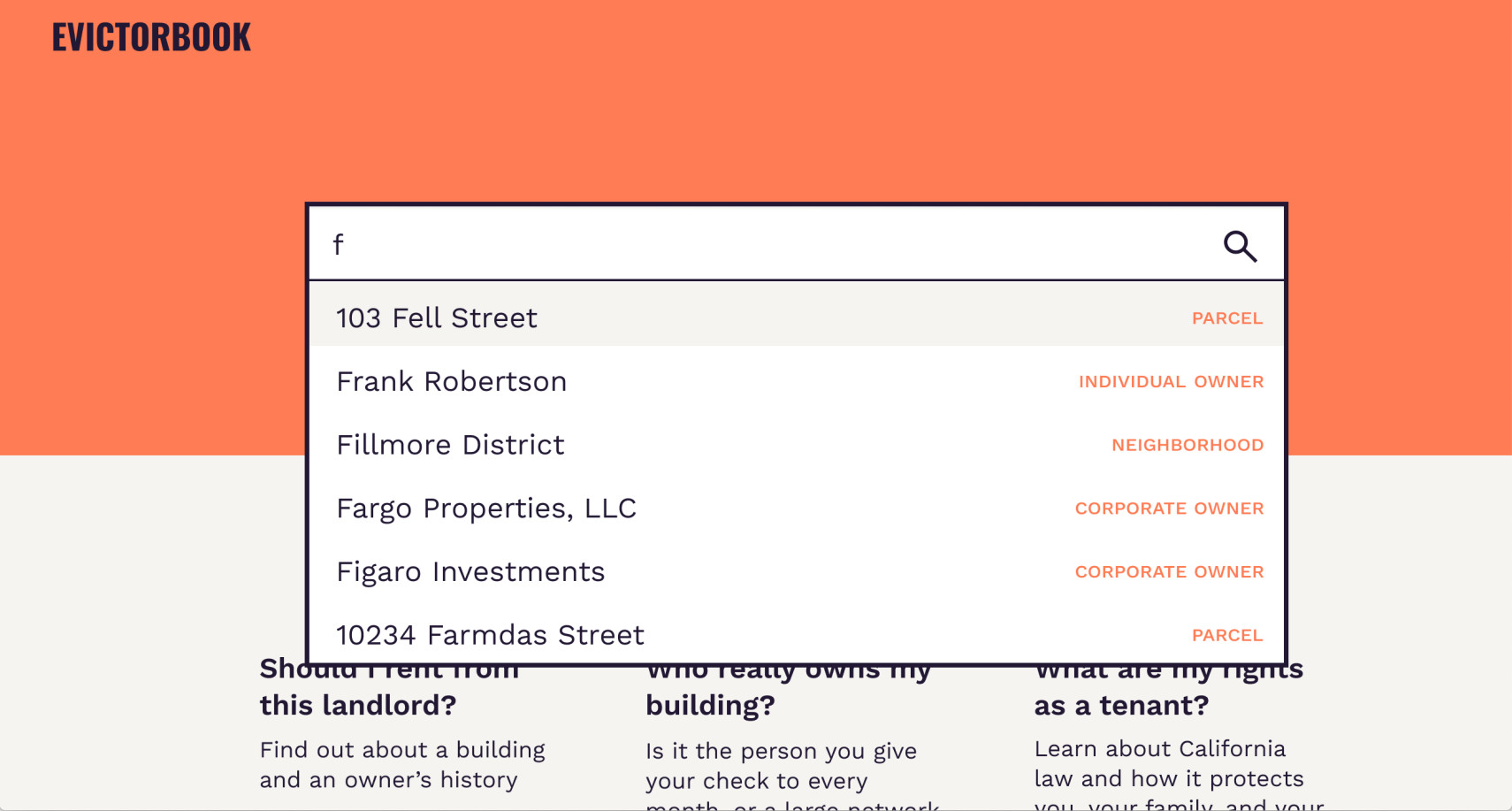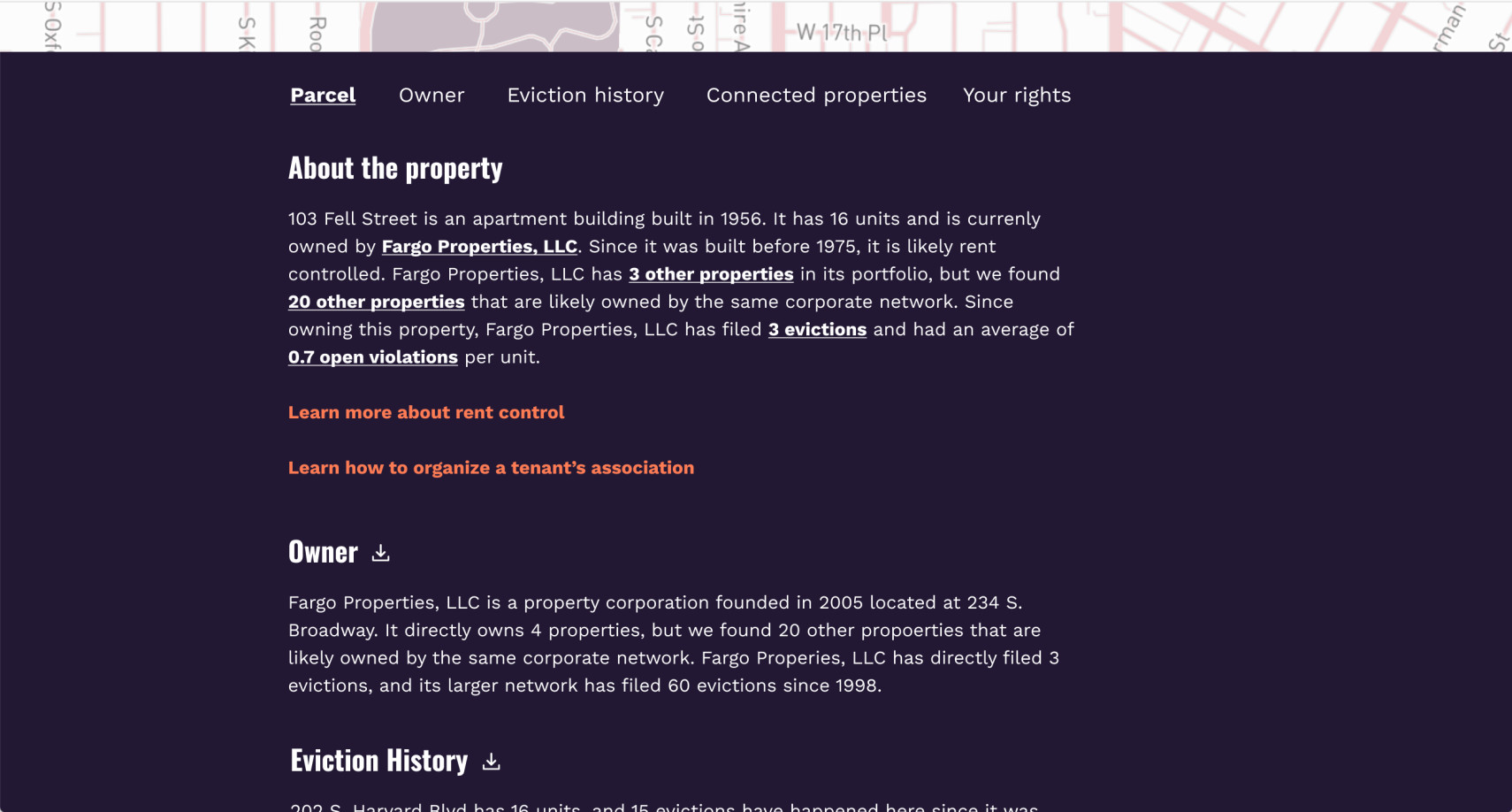Why did you make EvictorBook?
Erin: Particularly since 2008, we’ve seen the rise of corporate landlordism. We’ve seen huge investment companies—Blackstone and Invitation Homes are two of the biggest in the US, but there are many others—that will buy up swaths of property with unique limited liability company (LLC) or limited partnership names.
Take 55 Dolores Street LLC and 49 Guerrero Street LLC. These two LLCs are subsidiaries of Urban Green Investments, which is a big investment company that evicted many tenants in San Francisco in 2013. In the process of buying those properties, the company established a separate LLC for each one, which helped them with a number of things in terms of finance and liability, and also afforded them anonymity. It’s often very hard for tenants to know which other buildings in the city are owned by their landlord if each property has a unique-sounding ownership name.
When that was happening in 2013, the Anti-Eviction Mapping Project was just getting started, and we didn’t have a tool like EvictorBook, so we were doing property research manually. We’d create static websites where we’d list all the LLCs and all the evictions that we were able to connect to that investment company, with the idea that this information should be public and that tenant organizers should be able to use it for campaigns—ideally, multibuilding campaigns against large-scale landlords. They were essentially profile pages on different landlords. That’s useful because you have a much stronger chance of winning a fight against your landlord if you’re working together with other tenants across that landlord’s other buildings.
We also created a lookup tool and pledge map back in 2014. You can type in an address, see if there’s been an eviction there, and then pledge to not rent from that landlord. The map was pulling in public eviction data from the San Francisco Rent Board. The obvious next step was to connect other data to it, like parcel data and corporate ownership data. That turned out to be a lot harder than we realized, so it’s taken us some time. But that’s what the EvictorBook website does: it brings together a lot of those tools that we’ve already been using for years and makes it easier to see the landlords, LLC networks, and eviction histories of different buildings in San Francisco. You can enter an address or a landlord’s name, and we’ll show you a profile page with evictions connected to that entity.

How did you all build it?
Erin: The work began in early 2019 in collaboration with other member organizations of the San Francisco Anti-Displacement Coalition (SFADC), and in collaboration with the Mapping Action Collective (MAC) in Portland, Oregon.
Since then, we’ve done some workshops with different tenant groups to figure out what needs and questions they had given the new Covid conditions, and we’ve been really lucky to get new frontend people involved in development work. Right now, we’re making the site more user-friendly and doing more user testing in LA and Oakland.
Azad: The tenants unions in Los Angeles and San Francisco already do this kind of research when they’re fighting evictions. And organizers in other cities around the country are making similar tools, drawing from the same resources that we draw from: assessor data, property records, eviction data where possible, and sales data.
With EvictorBook, we’re just trying to make it easier, since tenants are most motivated to do this research when they’re already in crisis. They’re faced with belligerent landlords who harass them in all kinds of ways—ripping out appliances or sending fake legal notices to get people out.
Before we had EvictorBook, we’d start at the assessor’s office doing searches on paper and then look up what we could online. But property ownership networks have gotten very sophisticated. People wring out profits from one city and then move to other cities. So in the process of connecting all the data we’re working with, we’re also trying to map networks of financial speculators and evictors.
Have you heard about any surprising uses of EvictorBook?
Azad: There are a bunch of use cases. One is proactively asking: What has this landlord done in the past? Is this landlord representing themselves accurately?
Another is: Is this landlord lying to me about what’s taking place? In California, landlords can do what’s called an Ellis Act eviction, where they evict someone because they say they no longer want to rent out the building. In Los Angeles, there’s a five-year limit with this kind of eviction when the landlord is not allowed to rent out the unit they evicted someone from. But they can move in for a little while and then sell the property before five years are up. There are also owner move-in evictions that operate similarly. EvictorBook could tell you if something like that is the reason you’re being evicted.
Do landlords do these kinds of evictions in order to get rid of rent control in their buildings?
Erin: Indirectly, yes, because they can rent and sell the units for more money if there’s no rent control. In San Francisco, after a landlord uses the Ellis Act to evict tenants from a rent-controlled building, the building will often then get sold as multiple “tenancy in commons,” which will still have rent control—but then they will get converted into condos. And when that happens, the building loses rent control. That’s one of many loopholes. In short, what we’re seeing with Ellis Act evictions and Owner Move-In evictions is that we’re losing effective rent control, which, in the case of condo conversion, is a nonrenewable type of protection.
Azad: I was thinking we could add a feature to EvictorBook that shows how much a landlord profited from an eviction. We have the sale price before and the sale price after.
Erin: Oh, yeah, that would be great to see.
Azad: It wouldn’t be hard to do. We have all this data that we’re actually not spending much time analyzing. We know who the evictor of a given building was—and not just who evicted that one unit a few years ago, but looking back over fifteen, twenty years of evictions. That, combined with the networks of LLCs, shows not just ownership structures but also the evictor structures in the history of housing, which is the history of gentrification and the history of displacement in neighborhoods that are financialized. There are so many questions we could use this data to think about.

Half-Open Data
Erin: There are all these public datasets and open data portals that different cities have, but none of those datasets will indicate who corporate landlords or evictors are.
Azad: Or the stories of the people who are impacted.
Erin: Right. So the data that’s fueling EvictorBook is technically public, but people have to put zillions of hours into stitching it together for what we need. You would think that cities and different administrative bodies would do this work, but it’s not in their interest. So we’re taking public data and connecting it so that it can be useful to tenants.
I remember looking for rent stabilization data when I lived in New York, and the closest I found was this project, AmIRentStabilized.com, which is someone’s personal project to help people do this. The city has that data and could share it with tenants, but they don’t.
Erin: Totally.
Azad: And New York is a special case where there are different levels of rent stabilization and rent control, and the property owners know the status of their building, but it’s not easy for tenants to look up that information themselves.
The website walks you through the process of contacting a city office, which is then supposed to mail you the answer, but if they don’t, you’re supposed to set a calendar reminder for yourself to follow up with them!
Azad: That’s because these institutions are beholden to property owners who fight tooth and nail for data about them to remain inaccessible. And with open data, as soon as the data gets politicized, it gets pulled. We just saw this in Chicago, where there were some open datasets about policing in the city—several reports were written about them—and then that open data got removed. The neoliberal fantasy that motivated the open data movement in the first place was like, “If you just open the data, people will make great business products out of it!” But it’s proven to be much more complicated.

It’s also a ton of ongoing work to maintain that data and keep producing clean datasets. We want to be very transparent in EvictorBook. We’re not just saying: this person might own this property. We’re saying: there was an eviction here, this person owned the property during that eviction, and here’s why we’re sure of that. A ton of due diligence goes into that.
We’ve talked a lot over the course of this project about how we can avoid replicating some of the horrible data practices of property tech. Landlords have blacklists on prospective renters that they create by doing a regex [Ed: short for regular expression, a way of defining a pattern and then finding matches that fit the pattern] on five characters of a last name, without any other verifying information. That’s a great way to block large swaths of entire demographic populations from renting. We’re being extremely careful about that kind of thing.
Tell me more about these lists of renters based on five characters of a last name. I usually think of landlord tech more as surveillance cameras in buildings.
Azad: It’s that too.
Erin: Tenant screening has been around since the mid-1970s and has experienced different booms, such as a big one after 9/11 and another one after 2008. It’s getting more and more robust as an industry, weaving together past eviction history with any criminal record history that someone might have, along with credit reporting. There are so many bad data practices within each step. Of course, people are being wrongly criminalized at the outset, but also, oftentimes, these screening bureaus only look to see if a tenant has appeared in any kind of housing court—not necessarily what the outcome of the case was. So someone may have reported that their landlord was abusive, which gets their name registered in some database because they filed a complaint. It’s a mess.
Azad: We talked to eviction lawyers who were shocked that those lists were out there. We assumed that they knew, but they were like, “No, there is no central repository.” There’s just a patchwork of data on people who have been evicted. I think tenant screening companies literally just sell CSVs back and forth.
Erin: Different states have different policies about this. A few years ago, California passed a law that’s supposed to protect tenants from having their data collected by these screening companies. New York just last year passed a law that bans tenant blacklists. But apparently it’s still happening in both California and New York despite these laws. More broadly, there’s not a lot of regulation or enforcement around how these companies get data. In New York, LexisNexis sends its own people to housing court to take photos of the computers with all the eviction records. Then they bring those back, standardize them, and sell the data to tenant screening companies. Really weird things like that!
The surveillance you mentioned is also part of the property technology, or proptech, umbrella, which involves biometric data and all kinds of other tools and practices. We have been having a lot of conversations with other organizers about how to ensure that we don’t put data out there that can be used against tenants.
That gets to a security issue: there are housing justice groups already using EvictorBook, but it’s not publicly available yet. Can you talk about how you’re thinking about whether or not to make it public?
Azad: We’ve been thinking through worst-case scenarios: how could this data be used in a way that we didn’t plan for? What if the data was hacked? The eviction data is something we have access to that most people do not. We’ve gotten it through relationships with the courts, housing boards, and tenant organizers. So the raw data itself will probably remain restricted. But the rest of the site will be public and usable.
Erin: We’ve been weighing the risks of putting it out there—there’s always more verification of the data that can be done. On the other hand, there are risks involved in not putting it out there—it could be useful to people organizing rent strikes right now, particularly with Covid.
Anti-eviction Constellation
Chapters are a relatively new thing for AEMP. AEMP used to be limited to San Francisco. As the group grows, how do you keep the focus on housing justice that the original chapter has?
Erin: One of the things that I’ve always valued about AEMP is that people come in with such different backgrounds. Probably half of the people in the collective are doing narrative-based and storytelling work. There is a growing crew that’s bringing software skills, which are necessary—but we do work collectively to stay as far away as possible from Silicon Valley tech culture in our processes, in how we conceive our projects, and in how we work with community partners. The housing justice politics undergirding our work are first and foremost. Many people in the project are also in tenants unions, show up in different coalition meetings, and/or participate in actions.
We’re also a young organization. When we began in 2013, our group was housed in the San Francisco Tenants Union, which has been around for decades, as have many other orgs we’ve worked with. When the LA and New York chapters started, people in those places did a lot of outreach to figure out what kind of organizing was already happening in their cities.
Azad: In every chapter, there’s pretty tight integration with tenants unions. I know in LA there are four or five chapters across the city, and we have people going to meetings at most of those. We see ourselves as beholden to that movement; it’s built into our projects, the community agreements we’ve written, and the onboarding. We’re very clear that we’re not just building whatever tech.
The Anti-Eviction Mapping Project is always juggling collaborations with multiple other groups. At the same time, both of you have mentioned the zillions of hours that have gone into EvictorBook alone. How are you sustaining these efforts in a volunteer project?
Azad: I don’t know how Erin keeps it all together. I’m on two projects and it’s a full-time commitment.
Erin: You do so much, Azad. He’s working on both EvictorBook and the COVID-19 Global Housing Protection Legislation and Housing Justice Action Map, which tracks tenant protections, housing justice actions, landlord retaliation, and soon will include tenants’ oral histories since Covid.
It’s an interesting moment because, for a while, we had these three chapters, and each chapter was working on its own projects, so I don’t even know a lot of what’s happening in places where I’m not there, going to those meetings. I know in the Bay, there’s a thirty-minute film that’s an homage to tenant organizing that weaves together three struggles: the anti-Google fight in San Jose, the fight for rent control in Santa Rosa, and the fight for Aunti Frances’s home—she’s a former Black Panther who was evicted from her home in Oakland a few years ago. Our Counterpoints atlas will come out later this year with PM Press. That’s a project that many, many people have been working on for almost three years. Probably well over a hundred people contributed to the atlas, some affiliated with AEMP and others not. There’s also the Black Exodus zine that came out last year that tracks Black experiences of gentrification and resistance in San Francisco. I’m sure Azad knows about a lot of projects in LA that I don’t know about.
With EvictorBook, we started this interchapter collaboration model that more of our work is taking on, since Covid means that we’re all meeting online and not in person anyway. We’re having interchapter meetings every month whereas we used to have those every few months. But, yeah, it’s all volunteers, and we’re always trying to find ways to create more sustainability and be better organized. People are dedicated, and it somehow keeps going.
Azad: I think it’s partly that these are decentralized projects, and we’re just providing a framework. The framework is: How does this relate to housing justice? You’re not just making this for your own curiosity or to scratch your own itch; you can do that by yourself. So what is the nexus between how we see our role in the housing movement and the kinds of group projects that people are willing to take on?
When the LA chapter started, we would pair with another organization in the movement and they would say, “Help us look into this.” More recently, it’s become less of that model. Instead, we have a north star—it might be a little vague—and within that project, people are decentralized and empowered to work toward the ends they define. That’s the post-and-beam structure that AEMP provides.
What would you say is the north star of all of these projects? What do you see them as building toward?
Erin: This is not an AEMP-affiliated project in any way, but we’re really inspired by the Moms for Housing movement, which has shifted the conversation in the Bay Area. Four Black mothers in Oakland who had been unhoused organized to reclaim a home that was sitting vacant. It was owned by Wedgewood, which is one of these big investment companies with many LLCs throughout California. They were asking: Why should there be this vacant home owned by this corporate landlord when there are so many people who need housing now? The mothers helped create a huge movement in Oakland that inspired people in LA and beyond to do similar organizing. That spirit, that politic, has all sorts of afterlives, particularly in this intense moment where eviction moratoriums are ending while there’s still a pandemic going on.
Azad: What’s the north star? That’s a question that I think everyone who does work like this asks themselves. Is it about resisting, is it about building toward something new, is it about throwing sand in the gears? For me, it’s a mix of all of the above: community land trusts, decommodified housing—and let’s also repeal the state proposition that bans new public housing from being built in California! But more broadly, I think the idea is to keep making constellations. We’re providing north stars for others, and they provide them for us.
